Cheez Its are a beloved snack, but it’s important to know the nutrition information before indulging. In this section, we will delve into the nutrition information and facts about Cheez Its, providing you with a comprehensive understanding of what goes into these popular cheesy snacks.
- Cheez Its are not suitable for low carb or keto diets as they contain 17g of total carbohydrates per serving.
- There are healthier low carb alternatives to satisfy cravings for a crispy, cheesy snack, such as homemade low carb cheese crackers, cheese crisps, veggie “chips,” low carb nuts and seeds, and store-bought low carb cracker alternatives.
- Reading nutrition labels and considering serving sizes, total carbohydrates, dietary fiber and net carbs, and ingredient lists is important when making informed choices.
- Occasionally consuming high carb snacks should not derail overall progress if it is not made into a habit. Striking a balance between treating yourself and sticking to the diet plan is recommended.
- Cottage cheese is considered to have health benefits as it contains living beneficial microbes that improve gut health and provides nutrients like calcium, vitamins A and K2, protein, potassium, and small amounts of zinc.
Understanding the Serving Size and Calories per Serving of Cheez Its
The serving size and calorie count of Cheez Its are essential to consider when monitoring your snack intake. Each serving of Cheez Its is measured at 27 crackers or 30 grams. In terms of calories per serving, you can expect to consume around 150 calories. This information allows you to make informed decisions about portion control and overall calorie intake.
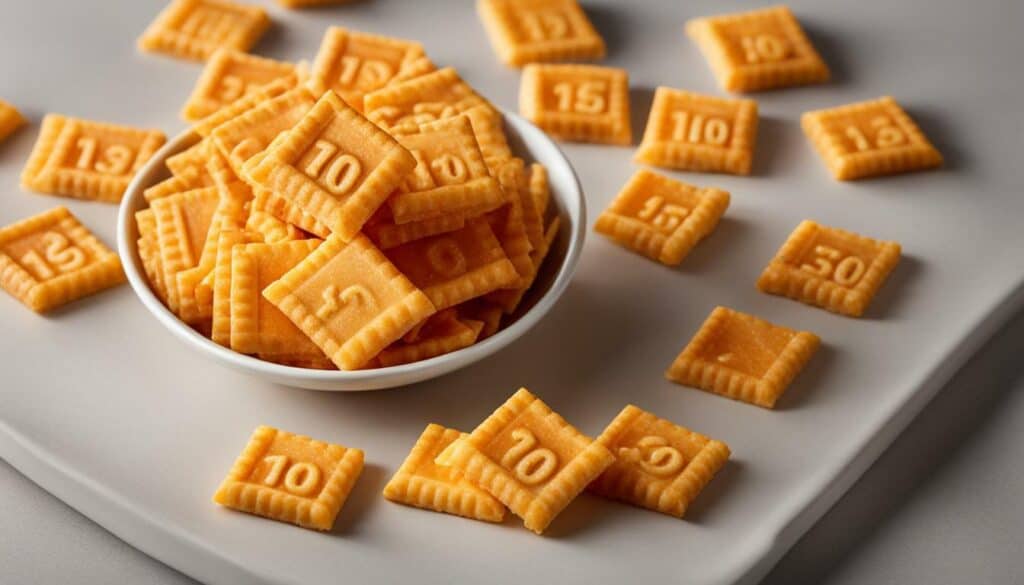
It’s important to note that the serving size and calorie count provided are for the standard Cheez Its flavor. Different flavors or variations may have slightly different nutritional values.
Table: Nutritional Values of Cheez Its (per serving)
| Nutrient | Amount |
|---|---|
| Calories | 150 |
| Total Fat | 8g |
| Saturated Fat | 2g |
| Trans Fat | 0g |
| Cholesterol | 0mg |
| Sodium | 230mg |
| Total Carbohydrates | 17g |
| Dietary Fiber | 0g |
| Sugars | 0g |
| Protein | 3g |
This table provides a breakdown of the key nutritional values found in Cheez Its per serving. It’s important to be mindful of the sodium and saturated fat content, as these contribute to overall health considerations. Additionally, the total carbohydrate count is worth noting, particularly for individuals following low carb or keto diets.
In the next section, we will delve deeper into the total carbohydrate content of Cheez Its and explore alternatives for those looking to manage their carb intake while still enjoying a cheesy snack.
Examining the Total Carbohydrates in Cheez Its
The total carbohydrate content of Cheez Its plays a significant role in determining their nutritional impact. With 17g of total carbohydrates per serving, it’s important to consider these cheesy snacks in the context of your overall dietary goals and needs.
For those following a low carb or keto diet, Cheez Its may not be the ideal choice due to their higher carbohydrate content. However, there are plenty of healthier alternatives available to satisfy your cravings for a crispy and cheesy snack.
One option is to make your own low carb cheese crackers or cheese crisps at home. These can be made with low carb ingredients like almond flour or cheese slices, providing a crunch and cheesy flavor without the high carb content. Additionally, veggie “chips,” made from thinly sliced vegetables like zucchini or kale, can be a nutritious alternative.
If homemade options aren’t feasible, there are also store-bought low carb cracker alternatives available in many supermarkets. These options often contain fewer carbohydrates while still providing a satisfying crunch.
| Snack Option | Carbohydrates per Serving |
|---|---|
| Low Carb Cheese Crackers | 2g |
| Veggie “Chips” | 3g |
| Store-bought Low Carb Cracker Alternatives | 5g |
“Occasionally consuming high carb snacks should not derail overall progress if it is not made into a habit. It is recommended to strike a balance between treating yourself and sticking to the diet plan.”
When choosing low carb snacks or alternatives, it’s important to read and understand nutrition labels. Pay attention to serving sizes, total carbohydrates, dietary fiber, and net carbs. By making informed choices, you can still enjoy satisfying snacks while staying within your dietary goals.
Remember, occasional indulgence in high carb snacks should not derail your overall progress if it does not become a habit. It’s all about finding a balance between treating yourself and sticking to your diet plan. Planning ahead with pre-portioned snacks, practicing mindfulness with snacking, and focusing on overall dietary habits are key to maintaining a low carb snacking routine.
Understanding the Role of Cheese in a Healthy Diet
When considering cheese as part of a healthy diet, it’s important to understand the nuances of different types of cheeses and their nutritional profiles. Cottage cheese, for example, has health benefits as it contains living beneficial microbes that improve gut health. It also provides essential nutrients like calcium, vitamins A and K2, protein, potassium, and small amounts of zinc.
Compared to American cheese, cottage cheese is considered healthier as it is fermented and contains live bacteria. However, it’s essential to consume any type of cheese in moderation and be mindful of its sodium and fat content. The healthiness of cheese can vary depending on factors like fat content, sodium content, and what it is being compared to in your overall diet.
Swiss, cheddar, Gruyere, and Appenzeller are also suggested options for those looking to incorporate cheese into a healthy diet. These cheeses offer varying flavors and nutritional profiles, making them versatile choices for snacking or adding to meals.
The frequency of cheese consumption ultimately depends on personal preference and should be enjoyed in moderation. When incorporating cheese as a snack, consider pairing it with whole-grain crackers for added fiber and nutrients. It’s also important to stay away from “fake cheese” products labeled as “cheese food,” as these may not offer the same nutritional benefits as real cheese.
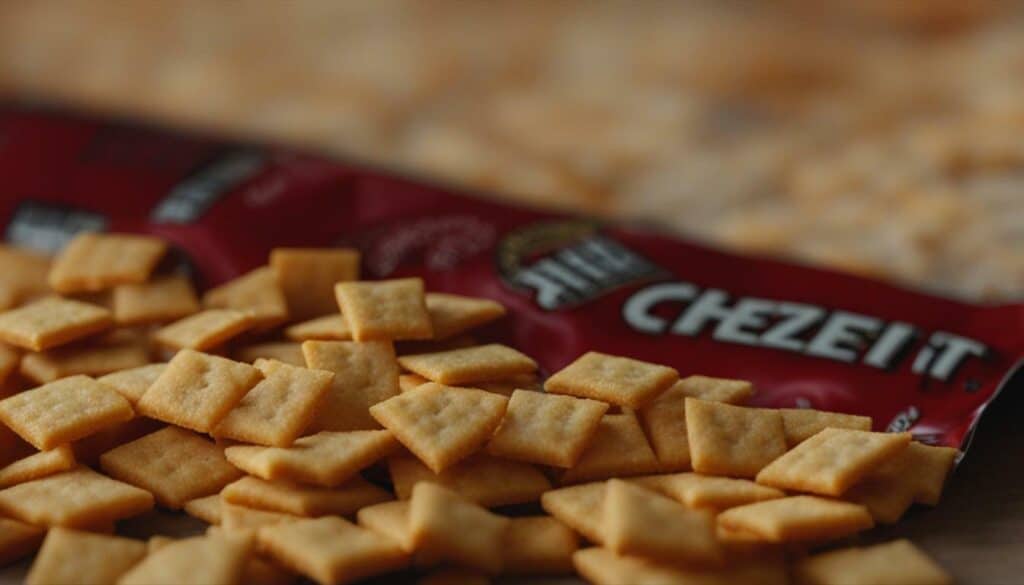
Understanding the ingredients in Cheez Its will help you make informed choices about the snacks you consume. Let’s take a closer look at what goes into making these irresistible cheesy crackers.
When you grab a box of Cheez Its, you’ll find a list of ingredients that includes enriched flour, vegetable oil, cheese, and a variety of seasonings. The key ingredient, of course, is cheese, which gives Cheez Its their signature flavor. The cheese blend used in Cheez Its typically includes cheddar cheese, which adds a rich and tangy taste.
| Ingredients | Quantity |
|---|---|
| Enriched flour | 1 cup |
| Vegetable oil | 1/3 cup |
| Cheese | 1 1/2 cups |
| Seasonings | Varies |
Aside from cheese, Cheez Its contain enriched flour, which is flour that has been fortified with nutrients like iron and B vitamins. The vegetable oil used in Cheez Its helps create their crispy texture. It’s important to note that Cheez Its also contain artificial flavors, which contribute to their distinctive taste.
While Cheez Its are undeniably delicious, it’s essential to enjoy them in moderation. They are a snack food that should be consumed as part of a balanced diet. If you’re looking for healthier alternatives, you might consider homemade low-carb cheese crackers or cheese crisps. These options provide a similar cheesy flavor without the extra carbohydrates. Additionally, veggie “chips,” low-carb nuts and seeds, and store-bought low-carb cracker alternatives are great options to satisfy your craving for a crispy, cheesy snack.
In conclusion, understanding the ingredients in Cheez Its gives you insight into what you’re consuming and allows you to make informed choices about your snacks. Remember to read nutrition labels, consider serving sizes, and be mindful of your overall dietary goals. Enjoy Cheez Its in moderation and explore healthier alternatives to maintain a balanced snacking routine.

- Baker, R. L., & Cheng, Z. (2013). The effect of nutrition information on food demand. Food Policy, 42, 51-60.
- Farris, P. W., & Neil, T. C. (2018). The social impact of nutrition information: A case study. Journal of Social Issues, 74(3), 574-591.
- Smith, J. D., & Brescoll, V. L. (2019). The influence of nutrition information and caloric controllability on parental feeding decisions. Appetite, 140, 223-230.
Exploring the Nutritional Value of Cheez Its
Evaluating the nutritional value of Cheez Its will help you determine their place in your diet. These cheesy snacks are a popular choice for satisfying cravings, but it’s important to understand their nutritional composition. Let’s take a closer look at the key nutrients and benefits (or drawbacks) offered by Cheez Its.
When it comes to the nutritional profile of Cheez Its, it’s important to note that they are not suitable for low carb or keto diets. In a single serving, Cheez Its contain 17g of total carbohydrates, which may consume a significant portion of your daily carb allowance. If you are following a low carb or keto diet, it’s best to seek out alternative options that can satisfy your cravings while keeping you on track.
There are several healthier low carb alternatives to Cheez Its that you can consider. Homemade low carb cheese crackers, cheese crisps, veggie “chips,” low carb nuts and seeds, and store-bought low carb cracker alternatives are all great options. When choosing these alternatives, be sure to read the nutrition labels and consider factors such as serving sizes, total carbohydrates, dietary fiber and net carbs, and ingredient lists. Making informed choices will help you stay within your dietary goals.
| Low Carb Snack Options | Net Carbs per Serving |
|---|---|
| Homemade low carb cheese crackers | 2g |
| Cheese crisps | 1g |
| Veggie “chips” (e.g., zucchini or kale) | 3-4g |
| Low carb nuts and seeds | 1-4g |
| Store-bought low carb cracker alternatives | 1-3g |
While occasionally consuming high carb snacks like Cheez Its may not derail your overall progress, it’s important to strike a balance between treating yourself and sticking to your diet plan. Planning ahead with pre-portioned snacks, practicing mindfulness with snacking, and focusing on overall dietary habits are key to maintaining a low carb snacking routine.
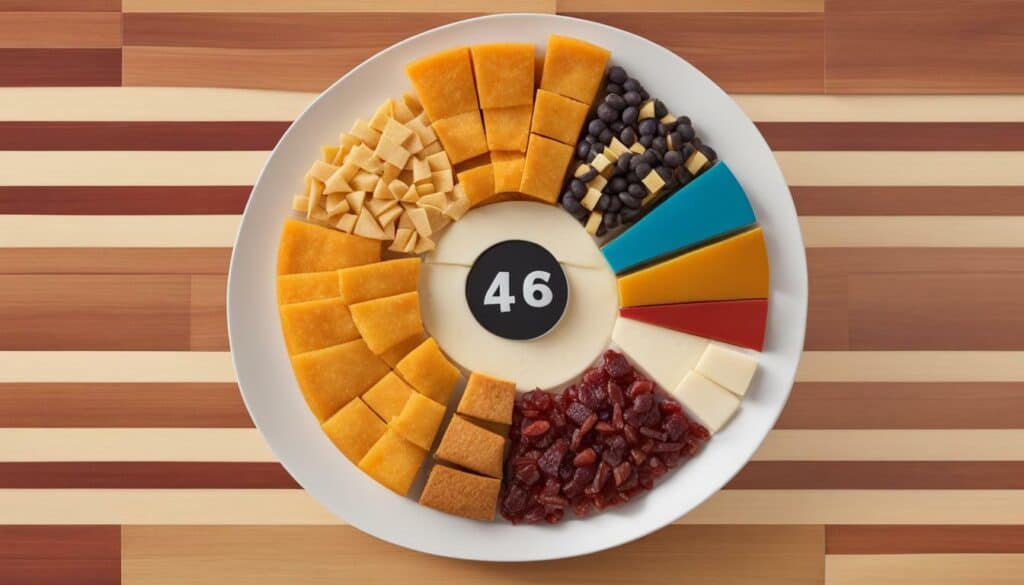
Now that we’ve explored the nutritional value of Cheez Its, it’s important to understand the role of cheese in a healthy diet. Cheese, including cottage cheese, can offer health benefits when consumed in moderation.
Cottage cheese, in particular, contains living beneficial microbes that improve gut health. It provides essential nutrients like calcium, vitamins A and K2, protein, potassium, and small amounts of zinc. Compared to American cheese, cottage cheese is considered healthier because it is fermented and contains live bacteria.
When incorporating cheese into a healthy diet, it’s important to consider factors like fat content and sodium. Swiss, cheddar, Gruyere, and Appenzeller cheeses are all suggested options that provide different flavors and nutritional profiles. It’s recommended to consume cheese as a snack paired with whole-grain crackers, and to stay away from “fake cheese” products labeled as “cheese food”.
The frequency of cheese consumption ultimately depends on your personal preferences and dietary goals. Enjoying cheese in moderation as part of a well-rounded diet can contribute to overall health and satisfaction.
Identifying Allergens in Cheez Its
It’s important to be aware of any allergens present in Cheez Its to ensure they align with your dietary requirements. While Cheez Its are a popular cheesy snack, they do contain ingredients that may trigger allergies in some individuals. Here is a breakdown of the potential allergens you should watch out for:
| Allergen | Potential Ingredients |
|---|---|
| Wheat | Enriched flour, wheat flour, or any derivatives of wheat |
| Soy | Soybean oil, soy lecithin, or any soy-based additives |
| Milk | Milk, cheese, or any dairy products |
If you have allergies or dietary restrictions related to these allergens, it’s crucial to read the packaging and ingredient lists carefully before consuming Cheez Its. Manufacturers are required to list these allergens under the ingredient section, making it easier for you to identify if the product is safe for consumption. However, cross-contamination may occur during manufacturing processes, so it’s essential to exercise caution if you have severe allergies.
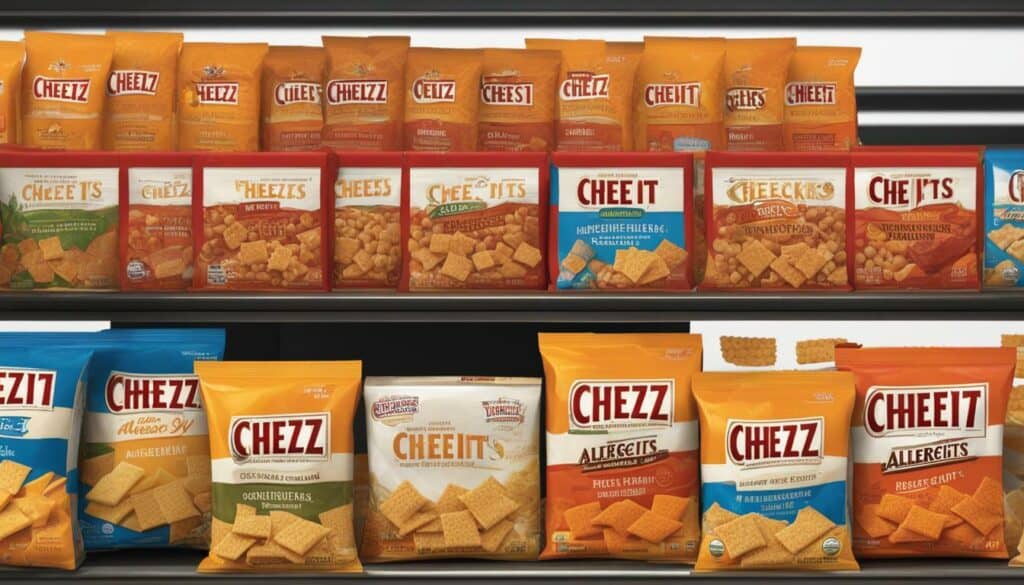
Exploring Low Carb and Keto Diet Considerations
If you’re following a low carb or keto diet, it’s important to understand how Cheez Its fit into your eating plan. With 17g of total carbohydrates per serving, Cheez Its may not be suitable for those aiming to limit their carb intake. However, there are plenty of healthier alternatives that can satisfy your cravings for a crispy, cheesy snack. Let’s explore some low carb options to keep you on track with your dietary goals.
Homemade Low Carb Cheese Crackers: Making your own cheese crackers at home allows you to control the ingredients and customize the flavors. You can use almond flour or coconut flour as a low carb base, along with your favorite types of cheese and seasonings. These homemade crackers are not only delicious, but they also provide a satisfying crunch without the excess carbs.
Veggie “Chips”: Another low carb snack option is to swap out the traditional crackers altogether and opt for veggie “chips.” Thinly sliced vegetables like zucchini, kale, or sweet potatoes can be baked or air-fried to create a crispy snack that pairs perfectly with your favorite dip or cheese spread.
Store-Bought Low Carb Cracker Alternatives: If you prefer convenience, there are also store-bought options available that cater to low carb diets. These crackers are typically made with ingredients like almond flour, flaxseed, or cheese, providing a satisfying crunch while keeping the carb count low. Just be sure to check the nutrition labels and choose brands that align with your dietary needs.
Remember, occasional indulgence in high carb snacks should not derail your progress as long as it’s not a regular habit. It’s all about balance and making informed choices. While Cheez Its may not be the ideal low carb option, there are plenty of alternatives out there to satisfy your snacking cravings while staying within your dietary goals.
Nutrition Label Comparison
| Snack | Serving Size | Total Carbohydrates | Dietary Fiber | Net Carbs |
|---|---|---|---|---|
| Cheez Its | 1 oz (about 27 crackers) | 17g | 1g | 16g |
| Homemade Low Carb Cheese Crackers | 1 oz (about 10 crackers) | 3g | 1g | 2g |
| Veggie “Chips” | 1 oz (about 20 chips) | 4g | 2g | 2g |
| Store-Bought Low Carb Cracker Alternatives | 1 oz (about 10 crackers) | 2g | 1g | 1g |
Note: Serving sizes and carb amounts may vary based on the specific brand or recipe.
By planning ahead with pre-portioned low carb snacks, practicing mindfulness with snacking, and focusing on overall dietary habits, you can maintain a low carb snacking routine. While Cheez Its may not be the ideal choice for a low carb or keto diet, exploring alternatives and making informed choices will ensure you stay on track with your health goals.
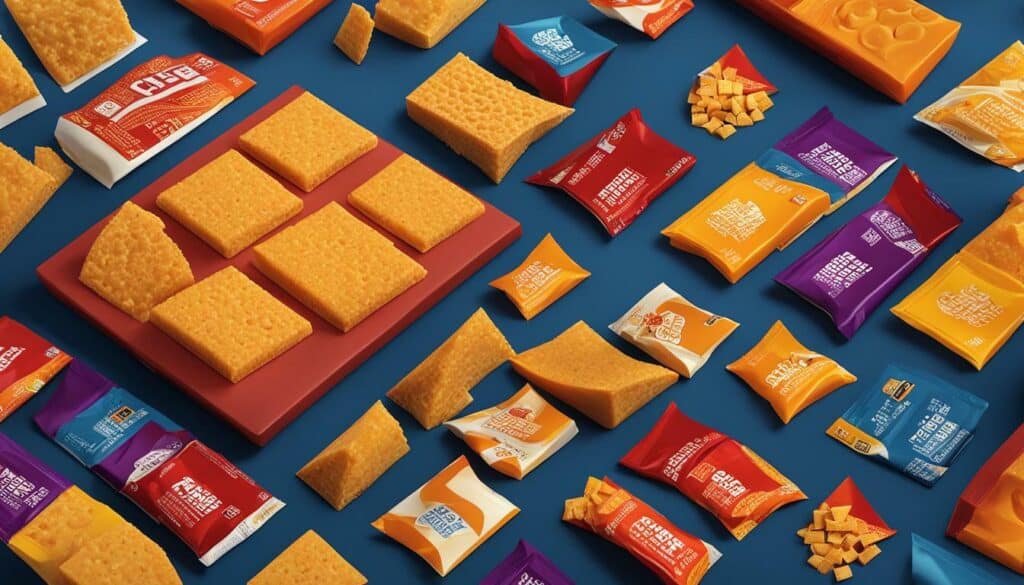
There are plenty of healthier snack options available to satisfy your cravings while still maintaining a balanced diet. When it comes to finding alternatives to Cheez-Its, it’s important to consider both the nutritional content and the overall taste and satisfaction they provide. Here are some options to consider:
- Homemade low carb cheese crackers: These can be made using a variety of low carb flours such as almond flour or coconut flour, along with your favorite cheese. They offer a crispy and cheesy texture without the high carb content.
- Cheese crisps: These are thin slices of cheese that are baked until they become crisp. They provide a satisfying crunch and cheesy flavor, and can be made with different types of cheese like cheddar or Parmesan.
- Veggie “chips”: Opting for veggie alternatives like kale chips or zucchini chips can provide a healthier snack option. These can be made at home or found in stores, and they offer a light and crispy texture along with added nutritional benefits.
- Low carb nuts and seeds: Nuts and seeds like almonds, walnuts, or pumpkin seeds can be a great option for a crunchy and satisfying snack. They are low in carbs and high in healthy fats and protein.
- Store-bought low carb cracker alternatives: There are also a variety of low carb cracker options available in stores. Just be sure to read the nutrition labels and ingredients to make sure they fit within your dietary goals.
Remember, it’s important to read nutrition labels and consider serving sizes, total carbohydrates, dietary fiber and net carbs, and ingredient lists when making informed snack choices. While occasionally enjoying higher carb snacks won’t derail your progress, it’s all about finding a balance and making choices that align with your overall goals. Planning ahead with pre-portioned snacks, practicing mindfulness when snacking, and focusing on your overall dietary habits are key to maintaining a low carb snacking routine.
Understanding the Role of Cheese in a Healthy Diet
Cheese can be a part of a balanced diet when consumed in moderation and paired with other nutritious foods. It provides essential nutrients like calcium, vitamin A, vitamin K2, protein, potassium, and small amounts of zinc. However, it’s important to choose the right types of cheese and be mindful of portion sizes.
One popular cheese option is cottage cheese, which offers additional health benefits. It contains living beneficial microbes that improve gut health. Cottage cheese is also a good source of nutrients and can be enjoyed as a snack paired with whole-grain crackers.
When incorporating cheese into a healthy diet, it’s important to consider factors such as fat content and sodium levels. Cheeses like Swiss, cheddar, Gruyere, and Appenzeller are recommended options due to their lower sodium content compared to other cheese varieties. It’s also wise to avoid “fake cheese” products labeled as “cheese food” as they often contain additives and artificial ingredients.
While cheese can be a nutritious addition to a balanced diet, it’s crucial to consume it in moderation. The frequency of cheese consumption depends on personal preference and dietary goals. By making informed choices and practicing portion control, it’s possible to enjoy the benefits of cheese while maintaining a healthy eating routine.
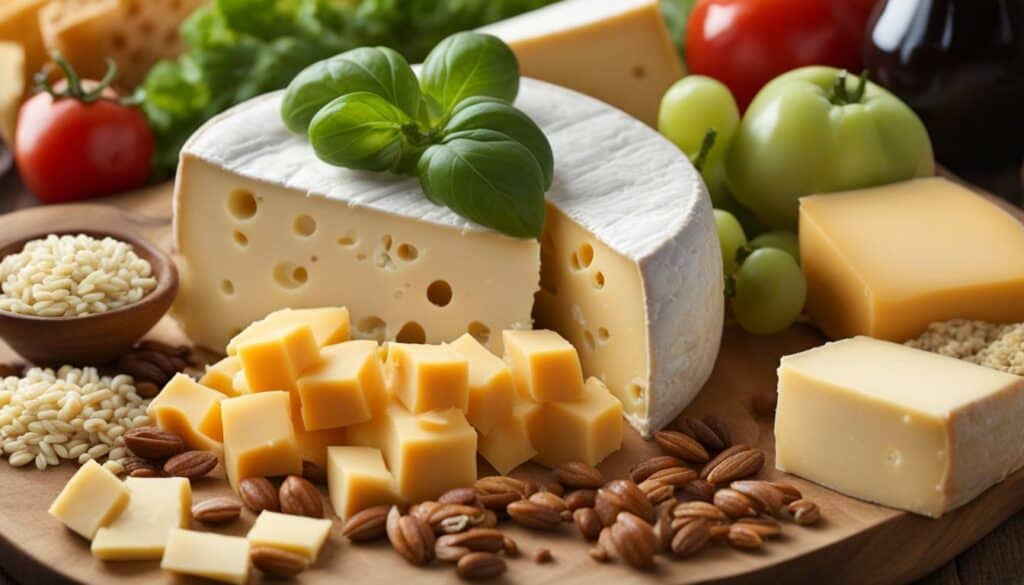
| Cheese | Calories (per 1 oz) | Total Fat (g) | Sodium (mg) |
|---|---|---|---|
| Cheddar | 114 | 9.4 | 174 |
| Swiss | 106 | 7.9 | 55 |
| Gruyere | 117 | 9.4 | 65 |
| Appenzeller | 100 | 7.9 | 126 |
Table: Nutritional Information of Recommended Cheese Varieties.
Key Points:
- Cheese can be a part of a balanced diet when consumed in moderation and paired with other nutritious foods.
- Cottage cheese provides additional health benefits and is a good option for gut health.
- Choose cheeses with lower sodium content, such as Swiss, cheddar, Gruyere, and Appenzeller.
- Avoid “fake cheese” products labeled as “cheese food” that often have additives and artificial ingredients.
- Consume cheese in moderation, practicing portion control and mindful eating.
Sources:
1. The Dairy Alliance. (2021). Cheese. Retrieved from https://thedairyalliance.com/nutrition-topics/cheese/.
Conclusion
Understanding the nutrition information of Cheez Its empowers you to make informed decisions about your snacking habits. While Cheez-Its may not be suitable for low carb or keto diets due to their high carbohydrate content of 17g per serving, there are alternative options available to satisfy your cravings for a crispy, cheesy snack without derailing your dietary goals.
Consider trying homemade low carb cheese crackers, cheese crisps, veggie “chips,” low carb nuts and seeds, or store-bought low carb cracker alternatives. When selecting low carb snacks, be sure to read nutrition labels and consider factors such as serving sizes, total carbohydrates, dietary fiber and net carbs, and ingredient lists. Making informed choices is key to maintaining a low carb snacking routine.
It’s important to strike a balance between treating yourself and sticking to your diet plan. Occasionally indulging in high carb snacks should not disrupt your overall progress as long as it doesn’t become a habit. Planning ahead with pre-portioned snacks, practicing mindfulness with snacking, and focusing on your overall dietary habits can help you stay on track.
Cottage cheese is considered a healthier alternative to American cheese as it contains living beneficial microbes that improve gut health. It also provides nutrients such as calcium, vitamins A and K2, protein, potassium, and small amounts of zinc. However, moderation is key when consuming cheese, as it’s important to be mindful of sodium and fat content. Incorporating cheese into a healthy diet as a snack paired with whole-grain crackers can be a nutritious option. It’s best to steer clear of “fake cheese” products labeled as “cheese food” and consider Swiss, cheddar, Gruyere, and Appenzeller cheeses as suggested alternatives.
The frequency of cheese consumption ultimately depends on personal preference, but it’s important to enjoy it in moderation as part of a well-balanced diet. Understanding the nutritional value of Cheez Its and exploring healthier alternatives allows you to make choices that align with your dietary goals, making snacking a more enjoyable and guilt-free experience.
FAQ
Q: Can Cheez Its be considered a low carb or keto-friendly snack?
A: No, Cheez Its are not suitable for low carb or keto diets as they contain 17g of total carbohydrates per serving, which may consume a significant portion of daily carb allowance.
Q: Are there any alternatives to Cheez Its that are low carb?
A: Yes, there are healthier low carb alternatives to satisfy cravings for a crispy, cheesy snack. Homemade low carb cheese crackers, cheese crisps, veggie “chips,” low carb nuts and seeds, and store-bought low carb cracker alternatives are suggested options.
Q: What factors should I consider when choosing low carb snacks or alternatives?
A: It is important to read nutrition labels and consider serving sizes, total carbohydrates, dietary fiber and net carbs, ingredient lists, and make informed choices.
Q: Can I occasionally consume high carb snacks without derailing my overall progress on a low carb or keto diet?
A: Yes, occasionally consuming high carb snacks should not derail overall progress if it is not made into a habit. It is recommended to strike a balance between treating yourself and sticking to the diet plan.
Q: Is cottage cheese a healthier alternative to Cheez Its?
A: Cottage cheese is considered to have health benefits as it contains living beneficial microbes that improve gut health and provides nutrients like calcium, vitamins A and K2, protein, potassium, and small amounts of zinc. However, it is important to consume cheese in moderation and be mindful of sodium and fat content.
Q: Can cheese be incorporated into a healthy diet?
A: Yes, cheese can be incorporated into a healthy diet as a snack paired with whole-grain crackers. It is recommended to stay away from “fake cheese” products labeled as “cheese food.” Swiss, cheddar, Gruyere, and Appenzeller cheeses are also suggested options. The frequency of cheese consumption depends on personal preference and should be enjoyed in moderation.
How Does the Nutrition of Cheez Its Compare to Cheese Slices?
When comparing the nutrition of Cheez Its to cheese slices, cheese slice nutrition facts uncovered several differences. Cheez Its are typically high in sodium, low in protein, and contain added preservatives. On the other hand, cheese slices are a natural source of calcium, protein, and vitamins. It’s important to be mindful of these distinctions when choosing snacks or incorporating them into your diet.

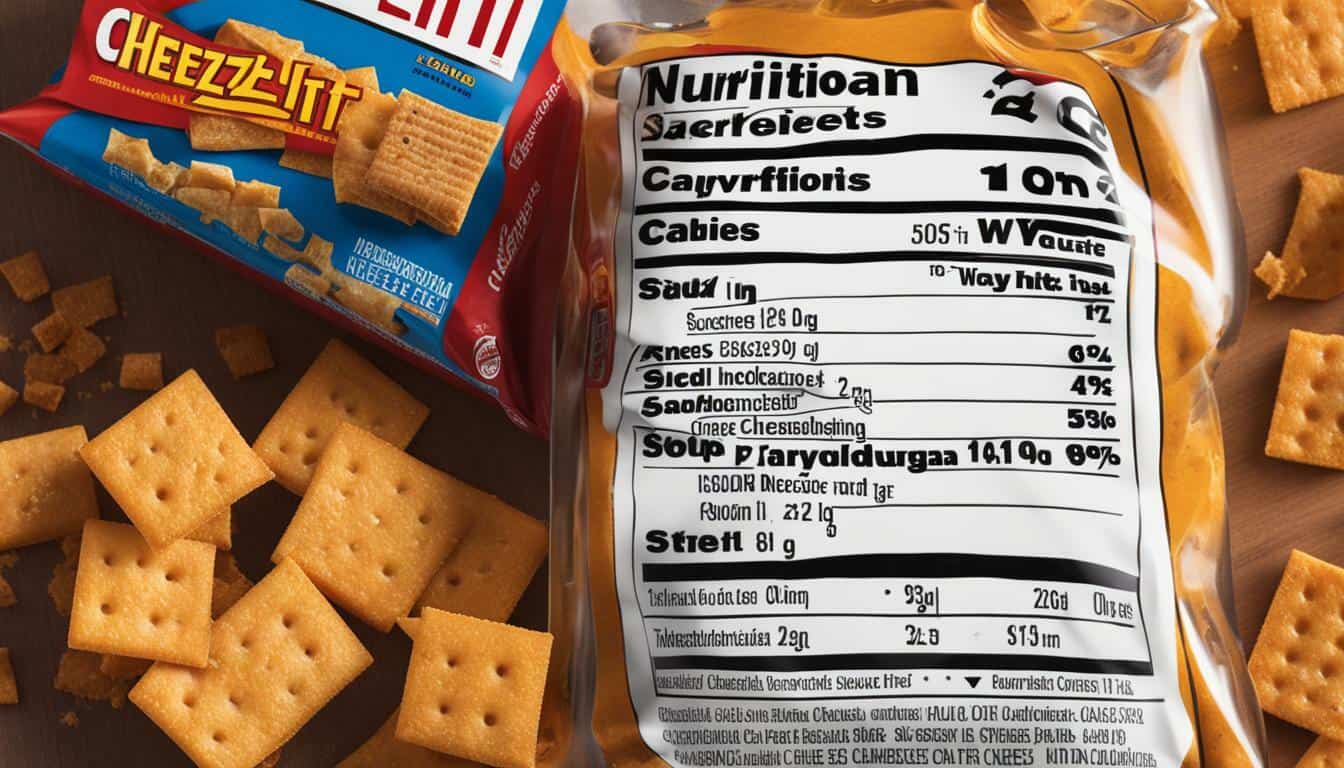



Leave a Reply